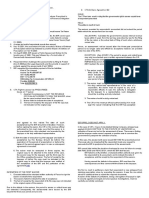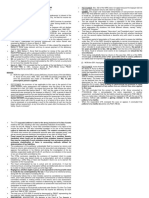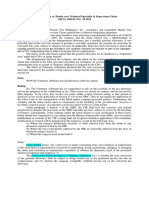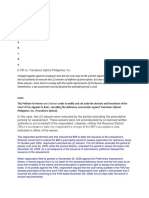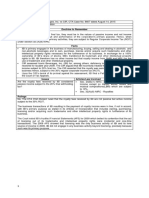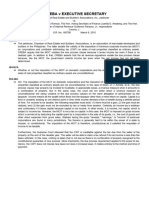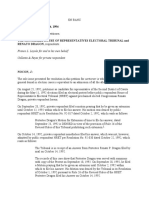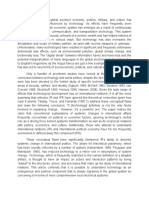0%(1)0% found this document useful (1 vote)
722 viewsCIR vs. LA FLOR DEla ISABELA, 2019
CIR vs. LA FLOR DEla ISABELA, 2019
Uploaded by
Fenina ReyesThe Supreme Court ruled that withholding taxes such as expanded withholding tax (EWT) and withholding tax on compensation (WTC) are internal revenue taxes covered by Section 203 of the National Internal Revenue Code. While the withholding agent is personally liable for failure to withhold and remit taxes, withholding taxes do not cease to be income taxes on the payee simply because they are collected and paid by the withholding agent. The aim of withholding tax assessments is to collect unpaid income taxes, not merely impose penalties on the withholding agent. Therefore, withholding tax assessments are deficiency internal revenue taxes within the scope of Section 203.
Copyright:
© All Rights Reserved
Available Formats
Download as DOCX, PDF, TXT or read online from Scribd
CIR vs. LA FLOR DEla ISABELA, 2019
CIR vs. LA FLOR DEla ISABELA, 2019
Uploaded by
Fenina Reyes0%(1)0% found this document useful (1 vote)
722 views3 pagesThe Supreme Court ruled that withholding taxes such as expanded withholding tax (EWT) and withholding tax on compensation (WTC) are internal revenue taxes covered by Section 203 of the National Internal Revenue Code. While the withholding agent is personally liable for failure to withhold and remit taxes, withholding taxes do not cease to be income taxes on the payee simply because they are collected and paid by the withholding agent. The aim of withholding tax assessments is to collect unpaid income taxes, not merely impose penalties on the withholding agent. Therefore, withholding tax assessments are deficiency internal revenue taxes within the scope of Section 203.
Original Description:
taxation
Copyright
© © All Rights Reserved
Available Formats
DOCX, PDF, TXT or read online from Scribd
Share this document
Did you find this document useful?
Is this content inappropriate?
The Supreme Court ruled that withholding taxes such as expanded withholding tax (EWT) and withholding tax on compensation (WTC) are internal revenue taxes covered by Section 203 of the National Internal Revenue Code. While the withholding agent is personally liable for failure to withhold and remit taxes, withholding taxes do not cease to be income taxes on the payee simply because they are collected and paid by the withholding agent. The aim of withholding tax assessments is to collect unpaid income taxes, not merely impose penalties on the withholding agent. Therefore, withholding tax assessments are deficiency internal revenue taxes within the scope of Section 203.
Copyright:
© All Rights Reserved
Available Formats
Download as DOCX, PDF, TXT or read online from Scribd
Download as docx, pdf, or txt
0%(1)0% found this document useful (1 vote)
722 views3 pagesCIR vs. LA FLOR DEla ISABELA, 2019
CIR vs. LA FLOR DEla ISABELA, 2019
Uploaded by
Fenina ReyesThe Supreme Court ruled that withholding taxes such as expanded withholding tax (EWT) and withholding tax on compensation (WTC) are internal revenue taxes covered by Section 203 of the National Internal Revenue Code. While the withholding agent is personally liable for failure to withhold and remit taxes, withholding taxes do not cease to be income taxes on the payee simply because they are collected and paid by the withholding agent. The aim of withholding tax assessments is to collect unpaid income taxes, not merely impose penalties on the withholding agent. Therefore, withholding tax assessments are deficiency internal revenue taxes within the scope of Section 203.
Copyright:
© All Rights Reserved
Available Formats
Download as DOCX, PDF, TXT or read online from Scribd
Download as docx, pdf, or txt
You are on page 1of 3
COMMISSIONER OF INTERNAL v. LA FLOR DELA ISABELA, INC.
G.R. No. 211289, January 14, 2019
SECOND DIVISION
(Reyes, J. Jr., J.)
FACTS:
La Flor dela Isabela, Inc. (La Flor) filed monthly returns for the Expanded Withholding
Tax (EWT) and Withholding Tax on Compensation (WTC) for calendar year 2005.
On January 7, 2010, La Flor received four Formal Letters of Demand and Final
Assessment Notices (FAN): (1) for penalties for late filing and payment of WTC; (2) for
penalties for late filing and payment of EWT; (3) for deficiency assessment for EWT;
and (4) for deficiency assessment for WTC. They were all dated December 17, 2009,
and covered deficiency taxes for the taxable year 2005.
The Commissioner of Internal Revenue (CIR) issued a Final Decision on Disputed
Assessment (FDDA) against La Flor involving the alleged deficiency withholding taxes.
Aggrieved, La Flor filed a petition for review before the Court of Tax Appeals (CTA)
Division.
The CTA Division ruled in favor of La Flor and cancelled the assessments. The CTA En
Banc affirmed the decision of the CTA division.
The CIR, in its petition to the Supreme Court, forwards a novel theory that Section
203 is inapplicable in the present assessment of EWT and WTC deficiency against La
Flor. It argues that withholding taxes are not contemplated under the said provision
considering that they are not internal revenue taxes but are penalties imposed on the
withholding agent should it fail to remit the proper amount of tax withheld.
ISSUE:
Are withholding taxes internal revenue taxes covered by Section 203 of the National
Internal Revenue Code (NIRC)?
RULING:
Yes.
In Chamber of Real Estate and Builders’ Associations, Inc. v. Hon. Executive Secretary
Romulo,1the Court had succinctly explained that the method of withholding tax at
source is a procedure of collecting income tax which is sanctioned by our tax laws.
Under the current system, the payee is the taxpayer, the person on whom the tax is
imposed, while the payor, a separate entity, acts as the government’s agent for the
agent personally liable for the breach of its legal duty to withhold the tax and remit the
same to the government.
Nonetheless, the Court does not agree with the CIR that withholding tax assessments
are merely an imposition of penalty on the withholding agent, and thus, outside the
coverage of Section 203 of the NIRC.
The CIR cites National Development Company v. Commissioner of Internal Revenue2 as
basis that withholding taxes are only penalties imposed on the withholding agent:
In effect, therefore, the imposition of the deficiency taxes on the NDC is a penalty for
its failure to withhold the same from the Japanese shipbuilders.
A careful analysis of the above-quoted decision, however, reveals that the Court did
not equate withholding tax assessments to the imposition of civil imposed on tax
deficiencies. The word “penalty” was used to underscore the dynamics in the
withholding tax system it is the income of the payee being subjected to tax and not of
the withholding agent. It was never meant to mean that withholding taxes do not fall
within the definition of internal revenue taxes, especially considering that income
taxes are the ones withheld by the withholding agent. Withholding taxes do not
cease to become income taxes just because it is collected and paid by the
withholding agent.
Thus, withholding tax assessments such as EWT and WTC clearly contemplate
deficiency internal revenue taxes. Their aim is to collect unpaid income taxes and not
merely to impose a penalty on the withholding agent for its failure to comply with its
statutory duty, and therefore, are within the application of Section 203 of the NIRC.
1 628 Phil. 508, 536 (2010)
Taxation Law: Income Tax: Withholding of Taxes: Concept of Withholding Taxes
9
the collection of the tax in order to ensure its payment. As a consequence of this system, two distinct
liabilities arise – one for the income earner/payee and another for the withholding agent, who is a mere
tax collector not a taxpayer. The agent is not liable for the tax as no wealth flowed into him. The Tax
Code only makes
You might also like
- Prices and Taxes of Locally-Manufactured Distilled Spirits 2013Document3 pagesPrices and Taxes of Locally-Manufactured Distilled Spirits 2013Imperator Furiosa100% (2)
- CIR Vs de La SalleDocument2 pagesCIR Vs de La SalleOlenFuerte100% (7)
- Commisioner of Internal Revenue vs. Lucio L. Co. Et Al Gr. No. 241424 February 26,2020Document1 pageCommisioner of Internal Revenue vs. Lucio L. Co. Et Al Gr. No. 241424 February 26,2020Juvenal HernandezNo ratings yet
- CIR v. Isabela Cultural Corp.Document4 pagesCIR v. Isabela Cultural Corp.kathrynmaydevezaNo ratings yet
- City of Pasig vs. Manila Electric Company DigestDocument1 pageCity of Pasig vs. Manila Electric Company DigestChard100% (1)
- CIR vs. La Flor Isabela 211289Document1 pageCIR vs. La Flor Isabela 211289magen100% (1)
- Part C 1 - CIR Vs Avon Products ManufacturingDocument4 pagesPart C 1 - CIR Vs Avon Products ManufacturingCyruz Tuppal75% (4)
- 23 Accenture Vs CIRDocument5 pages23 Accenture Vs CIRcharlougala100% (1)
- Cir v. LancasterDocument2 pagesCir v. LancasterGlyza Kaye Zorilla PatiagNo ratings yet
- CIR v. Kudos Metal CorporationDocument2 pagesCIR v. Kudos Metal CorporationAldrin TangNo ratings yet
- Cir VS AvonDocument3 pagesCir VS AvonKrishianne Labiano100% (1)
- Diageo Philippines, Inc. V. Commissioner of Internal RevenueDocument2 pagesDiageo Philippines, Inc. V. Commissioner of Internal RevenueDrave Mont100% (1)
- CIR Vs Seagate, GR 153866Document3 pagesCIR Vs Seagate, GR 153866Mar Develos100% (1)
- Cir vs. Pineda, 21 Scra 105 PDFDocument1 pageCir vs. Pineda, 21 Scra 105 PDFJo DevisNo ratings yet
- Case #38 - CIR vs. United Cadiz SugarDocument2 pagesCase #38 - CIR vs. United Cadiz SugarJeffrey Magada100% (2)
- Spouses Pacquiao vs. CTA and CIRDocument3 pagesSpouses Pacquiao vs. CTA and CIRRhea CagueteNo ratings yet
- 05 Aznar vs. CIRDocument2 pages05 Aznar vs. CIRAlec Ventura100% (1)
- Cir v. MeralcoDocument2 pagesCir v. MeralcoKhaiye De Asis AggabaoNo ratings yet
- Systra Phils Inc v. CIRDocument1 pageSystra Phils Inc v. CIRBRYAN JAY NUIQUENo ratings yet
- CIR v. Tours Specialist Inc.Document2 pagesCIR v. Tours Specialist Inc.Gyrsyl Jaisa GuerreroNo ratings yet
- 3M PhilippinesDocument2 pages3M PhilippinesKarl Vincent Raso100% (1)
- Contex Corp vs. CirDocument3 pagesContex Corp vs. CirKath Leen100% (1)
- Aznar vs. CTA - Case DigestDocument2 pagesAznar vs. CTA - Case DigestKaren Mae ServanNo ratings yet
- Maceda vs. Macaraig (1993)Document8 pagesMaceda vs. Macaraig (1993)NN DDLNo ratings yet
- Zuellig Pharma v. CIRDocument5 pagesZuellig Pharma v. CIRPaul Joshua SubaNo ratings yet
- Honda Car Phils vs. Honda Cars Technical Specialist & Supervisors UnionDocument1 pageHonda Car Phils vs. Honda Cars Technical Specialist & Supervisors UnionNej Adunay100% (2)
- Atlas Consolidated Mining V CIR (Case Digest)Document2 pagesAtlas Consolidated Mining V CIR (Case Digest)Jeng Pion100% (2)
- CIR vs. Filinvest Development Corp.Document2 pagesCIR vs. Filinvest Development Corp.Cheng Aya50% (2)
- Cir Vs AichiDocument3 pagesCir Vs AichiMaiti LagosNo ratings yet
- Case Digest #3 - CIR Vs - Mirant PagbilaoDocument3 pagesCase Digest #3 - CIR Vs - Mirant PagbilaoMark AmistosoNo ratings yet
- Commissioner of Internal Revenue vs. Premium Leisure Corp. CTA (En Banc)Document1 pageCommissioner of Internal Revenue vs. Premium Leisure Corp. CTA (En Banc)kimNo ratings yet
- Local TaxationDocument5 pagesLocal TaxationJanineGabrielleDelRosarioNo ratings yet
- CIR v. DLSU DigestDocument2 pagesCIR v. DLSU DigestNinya Saquilabon60% (5)
- 23 CIR Vs Secretary of Justice and PAGCORDocument4 pages23 CIR Vs Secretary of Justice and PAGCORIan Villafuerte100% (1)
- Cir VS AvonDocument3 pagesCir VS AvonnorieNo ratings yet
- CIR vs. Transitions Optical Philippines, IncDocument13 pagesCIR vs. Transitions Optical Philippines, IncJoy Ben-at100% (1)
- 123 CIR v. Mirant Pagbilao CorporationDocument3 pages123 CIR v. Mirant Pagbilao CorporationLuis PerezNo ratings yet
- Iconic Vs CIRDocument1 pageIconic Vs CIRVel June100% (1)
- CIR V Univation MotorDocument3 pagesCIR V Univation MotoriptrinidadNo ratings yet
- CIR V CA, CTA & ANSCORDocument3 pagesCIR V CA, CTA & ANSCORBananaNo ratings yet
- CIR vs. Pilipinas ShellDocument3 pagesCIR vs. Pilipinas ShellArchie Torres88% (8)
- SMI-Ed Vs CIRDocument1 pageSMI-Ed Vs CIRRodney SantiagoNo ratings yet
- 2 Digested Cir Vs CA and Commonwealth Management and Services CorporationDocument1 page2 Digested Cir Vs CA and Commonwealth Management and Services CorporationRoli Sitjar ArangoteNo ratings yet
- CIR v. NIPPON EXPRESS CORPORATIONDocument2 pagesCIR v. NIPPON EXPRESS CORPORATIONlexxNo ratings yet
- Case Digest of CIR v. Aichi ForgingDocument4 pagesCase Digest of CIR v. Aichi ForgingJeng Pion100% (1)
- CIR vs. ST Lukes DigestDocument2 pagesCIR vs. ST Lukes DigestKath Leen100% (4)
- Pagcor Vs BirDocument2 pagesPagcor Vs BirTonifranz SarenoNo ratings yet
- CIR Vs Toledo DigestDocument2 pagesCIR Vs Toledo DigestClar Napa100% (2)
- Bpi vs. Cir, GR No. 139736Document11 pagesBpi vs. Cir, GR No. 139736Ronz RoganNo ratings yet
- CIR vs. United SAlvageDocument3 pagesCIR vs. United SAlvageTheodore01760% (1)
- Marubeni V CIR DigestDocument4 pagesMarubeni V CIR DigestAlexis Elaine BeaNo ratings yet
- CIR v. John Gotamco & SonsDocument2 pagesCIR v. John Gotamco & SonsDaLe AparejadoNo ratings yet
- Kepco Vs Cir Case DigestDocument1 pageKepco Vs Cir Case DigestjovifactorNo ratings yet
- CIR Vs MarubeniDocument1 pageCIR Vs MarubeniMon DreykNo ratings yet
- Coca-Cola Bottlers v. Cir DigestDocument4 pagesCoca-Cola Bottlers v. Cir DigestkathrynmaydevezaNo ratings yet
- CIR v. LANCASTERDocument2 pagesCIR v. LANCASTERBaymaxNo ratings yet
- CIR v. La Flor Case DigestDocument1 pageCIR v. La Flor Case Digestlaurence obaobNo ratings yet
- COMMISSIONER OF INTERNAL REVENUE v. LA FLOR DELA ISABELA, INC.Document1 pageCOMMISSIONER OF INTERNAL REVENUE v. LA FLOR DELA ISABELA, INC.John Kenneth Jacinto0% (1)
- TAX Case Digest Batch 3Document13 pagesTAX Case Digest Batch 3manabatrozetteNo ratings yet
- GR No. 149636 - June 8, 2005 Double Taxation FWT - GRTDocument4 pagesGR No. 149636 - June 8, 2005 Double Taxation FWT - GRTMonica SorianoNo ratings yet
- QuizDocument14 pagesQuizJepoy Nisperos ReyesNo ratings yet
- Refugia vs. CA - Ejectment SuitDocument37 pagesRefugia vs. CA - Ejectment SuitFenina ReyesNo ratings yet
- Lui Ent. vs. Zuellig Pharma - Interpleader - LeonenDocument64 pagesLui Ent. vs. Zuellig Pharma - Interpleader - LeonenFenina Reyes100% (1)
- Loyola vs. HRETDocument6 pagesLoyola vs. HRETFenina ReyesNo ratings yet
- PP vs. Ancajas - RA 9344-Suspension of Sentence - CICLDocument21 pagesPP vs. Ancajas - RA 9344-Suspension of Sentence - CICLFenina ReyesNo ratings yet
- Mahinay vs. Dura TireDocument14 pagesMahinay vs. Dura TireFenina ReyesNo ratings yet
- Manzano vs. PerezDocument8 pagesManzano vs. PerezFenina ReyesNo ratings yet
- Insular Assurance vs. Heirs of Alvarez - Concealment - Rescission - InsuranceDocument26 pagesInsular Assurance vs. Heirs of Alvarez - Concealment - Rescission - InsuranceFenina ReyesNo ratings yet
- PP vs. Segundo - Chain of Custody - Corpus Delicti in Drug Cases - Quantum of Evidence - LeonenDocument19 pagesPP vs. Segundo - Chain of Custody - Corpus Delicti in Drug Cases - Quantum of Evidence - LeonenFenina ReyesNo ratings yet
- G.R. No. 164575 December 6, 2006 ROBERT P. WA-ACON, Petitioner, People of The Philippines, RespondentDocument9 pagesG.R. No. 164575 December 6, 2006 ROBERT P. WA-ACON, Petitioner, People of The Philippines, RespondentFenina ReyesNo ratings yet
- G.R. No. 115430 November 23, 1995 PEOPLE OF THE PHILIPPINES, Plaintiff-Appellee, ELIZABETH GANGUSO Y DECENA, Accused-AppellantDocument10 pagesG.R. No. 115430 November 23, 1995 PEOPLE OF THE PHILIPPINES, Plaintiff-Appellee, ELIZABETH GANGUSO Y DECENA, Accused-AppellantFenina ReyesNo ratings yet
- Que vs. PPDocument33 pagesQue vs. PPFenina ReyesNo ratings yet
- PP vs. ClaroDocument9 pagesPP vs. ClaroFenina ReyesNo ratings yet
- Manongsong vs. EstimoDocument12 pagesManongsong vs. EstimoFenina ReyesNo ratings yet
- G.R. No. L-59118 March 3, 1988 Juan Dizon and Soledad Ramos, Petitioners, Brig. Gen. Vicente Eduardo and Col. Teddy Carian, RespondentsDocument11 pagesG.R. No. L-59118 March 3, 1988 Juan Dizon and Soledad Ramos, Petitioners, Brig. Gen. Vicente Eduardo and Col. Teddy Carian, RespondentsFenina ReyesNo ratings yet
- De Lima vs. Mario Joel Reyes, PIDocument27 pagesDe Lima vs. Mario Joel Reyes, PIFenina ReyesNo ratings yet
- Gov of USA vs. PurgananDocument13 pagesGov of USA vs. PurgananFenina ReyesNo ratings yet
- Pangcatan vs. MaghuyopDocument11 pagesPangcatan vs. MaghuyopFenina ReyesNo ratings yet
- National Transmission Corporation vs. Ebesa, Et Al - AppealsDocument15 pagesNational Transmission Corporation vs. Ebesa, Et Al - AppealsFenina ReyesNo ratings yet
- People Vs Marie Teresa Pangilinan GR 152662Document13 pagesPeople Vs Marie Teresa Pangilinan GR 152662Verbosee VVendettaNo ratings yet
- Barrido vs. NonatoDocument11 pagesBarrido vs. NonatoFenina ReyesNo ratings yet
- General Knowledge On Bangladesh HistoryDocument8 pagesGeneral Knowledge On Bangladesh HistoryKuasha NirobNo ratings yet
- Director General TG 2Document3 pagesDirector General TG 22022l9336No ratings yet
- Writ of KalikasanDocument18 pagesWrit of Kalikasanraymond gwapoNo ratings yet
- Origen - Homilies On Genesis and Exodus, Pp. 72-88 (Noah's Ark)Document10 pagesOrigen - Homilies On Genesis and Exodus, Pp. 72-88 (Noah's Ark)Steven Dunkel100% (1)
- Gonzales Cannon 9-22-11 IssueDocument32 pagesGonzales Cannon 9-22-11 IssueNikki MaxwellNo ratings yet
- What's Up - Projeto Pedagógico - Biblioteca - Aula DigitalDocument1 pageWhat's Up - Projeto Pedagógico - Biblioteca - Aula DigitalomaildamariamiguiNo ratings yet
- Information System InfrastructureDocument55 pagesInformation System InfrastructureVinoth RajNo ratings yet
- Policy Guidelines On Classroom Assessment For The K To 12 Basic Education Program (BepDocument15 pagesPolicy Guidelines On Classroom Assessment For The K To 12 Basic Education Program (BepBrendalyn Aumada BanaynalNo ratings yet
- Carbonfootprintcalculator 2Document27 pagesCarbonfootprintcalculator 2republicfoodsindiaNo ratings yet
- Customer Perceived Satisfaction On Online ShoppingDocument28 pagesCustomer Perceived Satisfaction On Online ShoppingCasey AbelloNo ratings yet
- Research Lesson 4 5 and 6Document22 pagesResearch Lesson 4 5 and 6richardalesnadiotayjrNo ratings yet
- Discussion ContempoDocument4 pagesDiscussion ContempoJelou CuestasNo ratings yet
- Forwarding Instruction: Page 1 of 1Document1 pageForwarding Instruction: Page 1 of 1Vikas KNo ratings yet
- Unit Test Diss 2nd QuarterDocument4 pagesUnit Test Diss 2nd QuarterZenaida CarbonelNo ratings yet
- SB 628 (Beall) Enhanced Infrastructure Financing District (EIFD)Document5 pagesSB 628 (Beall) Enhanced Infrastructure Financing District (EIFD)Asset100% (1)
- TD RDF Rdfs+SolutionDocument6 pagesTD RDF Rdfs+Solutionlahoucine karkouchNo ratings yet
- Prayer Walking GuideDocument5 pagesPrayer Walking GuidesherryNo ratings yet
- Inglês: Aluno: Yago de Oliveira Da Silva 3° Ano A MatutinoDocument7 pagesInglês: Aluno: Yago de Oliveira Da Silva 3° Ano A MatutinoyagoNo ratings yet
- Escola - Inglês Name: - Surname: - Date: - / - / - Grade Class: - Number: - Worksheet NumberDocument3 pagesEscola - Inglês Name: - Surname: - Date: - / - / - Grade Class: - Number: - Worksheet NumberPeter JonesNo ratings yet
- Mid Term Appraisal - 11th Plan FullDocument500 pagesMid Term Appraisal - 11th Plan FullDheeraj012No ratings yet
- Tender Supply and Installation of Gym Equipments Delhi 02 03 2016Document14 pagesTender Supply and Installation of Gym Equipments Delhi 02 03 2016PIYUSH GARGNo ratings yet
- GB PDFDocument359 pagesGB PDFUlaganathanNo ratings yet
- Kopano Pumps Engineering and Mining ServicesDocument2 pagesKopano Pumps Engineering and Mining ServicesDanie GroblerNo ratings yet
- Cyber Security Audit Sample Report v2.1 PDFDocument6 pagesCyber Security Audit Sample Report v2.1 PDFOmmscon GroupNo ratings yet
- Role of Women in Fisheries and AquacultureDocument7 pagesRole of Women in Fisheries and AquacultureYared FikaduNo ratings yet
- Lecture 4 2016 ALMDocument70 pagesLecture 4 2016 ALMEmilioNo ratings yet
- Erp SynopsisDocument2 pagesErp SynopsisShruti MittalNo ratings yet
- Pen 2603 Community Corrections AssessmentDocument3 pagesPen 2603 Community Corrections Assessmentkagisowest39No ratings yet
- Semi Final Module in Lin 002 Language Culture and SocietyDocument4 pagesSemi Final Module in Lin 002 Language Culture and SocietyJohn Rey A. TubieronNo ratings yet









